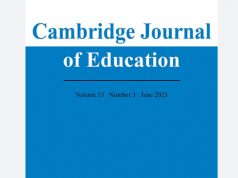Neil Selwyn writes on how digital technologies are altering the nature of education work … not always for the best. [January 2016]
INTRODUCTION
One of the great deceptions of the ‘digital age’ is the idea that digital technologies tend to lessen the need for hard work and generally improve people’s working lives. Technology marketing will often promote the sense that new and exciting things simply get ‘done’ through digital technologies without the need for work at all. At best, most people tend not to think about the work and labor involved in their use of digital technology. Yet the continued expansion of digital technology is intrinsically entwined with work. The ongoing digitization of contemporary society clearly involves substantial amounts of mental and manual labor, alongside significant shifts in the coordination and distribution of work.
These issues have begun to gain some recognition through exposés of the ‘brutal’ working conditions and cultures that sustain online shopping, ‘acceptable image filters’ and the manufacture of top-of-the-range smartphones. Questions are being raised over the enthusiastic rhetoric surrounding Uber, Airbnb and other ‘disruptors’ within the ‘sharing’ and ‘gig’ economies. All too often these apparently edgy, alternative ways of doing business appear to rely on diminished worker rights and employment liabilities. It seems that the benefits of the digital age come at considerable cost to those who are forced to labor behind the scenes.
So what implications might these trends have in the world of digital education? While usually judged solely in terms of learning and pedagogy, education technology is a site where much education work is now carried out. Whereas new technologies are often presumed to enhance the working lives of teachers and students, this clearly cannot always be the case. Instead, there needs to be greater recognition of the ways in which digital technologies might actually make education work more complex and difficult. The technological reconstitution of education work and working practices certainly merit greater scrutiny than is currently the case.
DIGITAL TECHNOLOGY AND THE RECONSTITUTION OF EDUCATION WORK
Here, then, are five burgeoning trends in education work that merit closer attention:
#1. The digital automation of education work
Algorithms, computational modeling and other forms of mathematical calculation are now used for a range of education processes that previously relied upon human judgment and professional decision making. This includes the use of ‘predictive analytics’ in tasks ranging from the hiring of new teachers to the identification of students at risk of dropping out of their courses. The past twenty years has also seen the significant automation of teaching and assessment work, such as the automated grading of essays and judgments whether students’ work has been plagiarized or not.
This faith in machine-based decision making is also apparent in the increasing use of ‘adaptive learning systems’ and similar ‘personalized learning’ applications that monitor and curate students’ online learning. These systems clearly represent the displacement of considerable amounts of teacher work. A company such as Knewton boasts of having made 15 billion recommendations of what to study to over 10 million students. The ‘world’s smartest tutor’ no longer needs to be human.
#2. The digital ‘sharing’ of education work
A defining feature of digital technology is the ease with which work can be (re)distributed. As services such as Amazon’s Mechanical Turk demonstrate, online work is easily divided into ‘micro’ fragments that can be completed by dispersed workers for equally ‘micro’ payments. Following these principles, the digital outsourcing of education work now takes place in a number of ways. For example, some universities delegate the design and development of their online courses to ‘virtual interns’ who can be engaged in unpaid ‘hope labor’ improving the university’s courses. Some teachers might outsource the marking of assignments and other onerous administrative work through global freelancing websites. These tasks are no longer things that well resourced education professionals must do for themselves.
Similarly, digital technologies allow students to outsource difficult or unappealing aspects of their education work. The internet has long been a source of essay mills and other ‘shadow’ services that can complete assessments and assignments for a fee. Extending this logic, students can now pay workers from online companies such as ‘No Need To Study’ to take their online courses – clicking through content, taking tests and posting discussion forum comments where appropriate.
#3. The digital recycling of education work
Digital education increasingly involves the re-use and re-appropriation of content. Teachers are urged to ‘embrace the remix’ and engage in ‘co-creative labor’ practices. For example, the notion of re-using other teachers’ PowerPoint slides is now common practice in school and university teaching. Understandably, a number of websites have emerged where entrepreneurial educators can resell their best lesson plans, slide-decks and other online content. As the New York Times enthused, such sites support a ‘sharing economy where teachers win’.
Notions of authorship and intellectual property are certainly altering as a result of technology-based teaching and learning. The argument is now being made that teachers can no longer expect to ‘own’ their own digital teaching content but are simply bought-in ‘guns for hire’ like actors in a film or stage production. As a result, teachers are beginning to find some major online platforms restricting access to the data generated from their own teaching. On occasion, teachers are even finding their originally authored materials being passed off and resold as the work of others.
#4. The digital measurement of education work
Digital technologies also support the increased quantification and measurement of education work. This takes a variety of forms. Online sites such as RateMyTeachers and RateMyProfessors offer students an anonymous means to compare judgments on their teachers’ ‘helpfulness’, ‘easiness’ and overall ‘hotness’. Conversely, the recent trend for ‘learning analytics’ offers educators and institutions a variety of ways to evaluate the quality of teachers’ work. There is a thriving market for commercial applications that allow teachers to generate ‘real time feedback’ from classes. Online surveys are also used regularly by schools, districts and government agencies to gauge ‘student satisfaction’, ‘attitudes to school’, ‘teacher well-being’ and other forms of feedback.
The digital monitoring of education work has expanded well beyond online applications. Organizations such as the Gates Foundation have pushed millions of dollars toward developing digital video surveillance of classrooms as a tool to support teachers to improve their teaching. Other innovations include the use of biometric ‘engagement pedometers’ and similar self-quantification technologies to gauge levels of student engagement and motivation. Such technologies have certainly helped schools and universities embrace the longstanding business mantra of ‘If You Can’t Measure It, You Can’t Manage It’.
#5. The digital expansion of education work
These examples notwithstanding, perhaps the most significant trend is the digital expansion of education work across space and time. In short, digital technology makes it considerably easier for teachers and students to engage with their work on a 24/7 basis regardless of location or time of day. Through cellphones, email, social media, learning management systems and other forms of e-learning, people can work in ways that best suit their individual circumstances rather than fit around the fixed institutional expectations of their school or university.
In particular, teachers are increasingly expected to communicate with students out of class on an ‘anytime, anywhere’ basis, monitor their classes’ after-school engagement with homework tasks, conduct lessons even when not physically in school, and deal with administration, planning and bureaucratic aspects of their work outside of classroom time. All told, teaching is no longer something that only takes place within the confines of the working day. These are the conditions of ‘edgeless’ institutions and ‘borderless’ education.
DISCUSSION
These examples give a sense of the fast changing nature of education work in the digital age. In many ways these education technologies simply reflect how ‘immaterial labor’ is now organized across society. Teachers and students are not the only people experiencing the blurring of work and leisure time. Education is not the only area of employment that relies on ‘precarious’ and unpaid labor. Principles of automation and ‘open’ production underpin many forms of contemporary technology use. As such, the changes just described could be celebrated as bringing modern efficiencies to the traditionally conservative work settings of the school and university. Many of the examples outlined are certainly faster-paced and more flexible than is the norm in education. These technologies undoubtedly allow education workers to be better connected and less confined by institutional restrictions.
There are benefits and improvements associated with these new ways of working. Yet there is also much to be wary of. In particular, the forms of work just described can be challenged in terms of their equity and ethics. It could be contended that these ‘new’ forms of education perpetuate much older forms of worker exploitation and disempowerment. For example, using unpaid interns and outsourcing administrative tasks could be seen as deliberate uses of technology to offload work onto vulnerable workers who are less powerful, non-unionized and can be employed at little or no cost. The recycling and/or reselling of teachers’ intellectual property could be framed in similarly exploitative terms. For all their efficiencies and flexibilities, it might be argued that few of these technological practices serve to advantage the people who are actually doing the work.
Also problematic are the ways that specific forms of work are obscured by digital technology, pushing certain aspects of what teachers and students do into the realm of non-labor. While many teachers will consider ‘clearing’ their email inboxes in the evenings and weekends as a necessary evil before commencing a day’s work, these activities are a core part of one’s daily work. Digital technologies are adept at converting some elements of education into what Trebor Scholz describes as ‘casual digital labor’ – i.e. mundane online tasks that don’t “feel, look, or smell like labor at all” (Scholz 2013, p.3). When scrolling through work emails in a restaurant what else are you doing but working?
Equally as insidious are the ways that the same digital technologies foreground other forms of work as somehow more important. Digital communications technologies and content management systems are key means of education work now being made ‘visible’ to a range of different audiences. Open-content, online evaluation and rating systems can be praised for bringing an enhanced transparency and accountability to education, but they are also powerful means of surveillance, control and discipline. The downside of having one’s work publicly documented through technology is an increased pressure to be ‘seen’ to do well, what many teachers and students might experience as “panoptic performativity” (Perryman 2006).
All told, digital technologies such as those described in this article are certainly altering the character of education work. More pointedly, all of these technologies infuse education with a sense of commodification and market logic. These are technologies that support wider imperatives to perform efficiently and ‘get things done’, thereby “focusing attention purely on the consequential” (Gregg 2015, p.187). This leads to perverse situations which contradict what many people would consider to be the underlying purpose and spirit of education. How have we reached a point where students are using websites to outsource the intellectual benefits (and perhaps even pleasures) of taking a course for themselves? Why would professional educators shirk the pedagogic responsibility of feeding-back on their students’ assignments?
CONCLUSIONS
These are not instances of digital technology improving, enhancing or transforming education. Instead, these examples point to a growing tendency for digital technology to support the fragmentation of education work and separation of the ‘conception’ of teaching and learning from its ‘execution’. The Ed Tech industry often celebrates the ‘unbundling’ of education processes, yet such technologies risk the ‘deskilling’ of teachers and students through the persistent standardization and separation of work, and subversion of professional judgment and expertise. To repeat a point made earlier, these are not technologies that advantage the majority of education workers.
At the heart of these technological changes is the reconstitution of labor processes from ones directed by workers to ones controlled by education managers and administrators, as well as government and commercial interests. In contrast to the enthusiastic claims that often accompany digital education, the long-term outcome of such technologies is likely to be the increased alienation and disengagement of those involved in education from their work. Of course, digital technology is not the root cause of these problems. Pressures of performativity, auditing, deskilling, life/work balance and the ‘casualization’ of labor have increasingly defined education systems since the 1980s. Yet, digital technologies are clearly enabling and amplifying such issues in schools and universities, and therefore merit more scrutiny and push-back.
So there is much that now needs to be done by everyone with an interest in the area of education and technology. To date these are issues, tensions and questions that have barely featured in discussions about ‘digital learning’ and ‘twenty-first century education’. This is an uneasy silence that should be broken. So how might things be otherwise? How might digital technologies be implemented in more equitable and empowering ways for education workers? How might everyone who labors in education engage in a collective ‘critical rethinking’ of how they want technologies to be used in their working lives and working environments? The real hard work of digital education starts here.
REFERENCES
Melissa Gregg (2015). Getting things done. In Ken Hillis, Susanna Paasonen and Michael Petit (eds). Networked affect. Cambridge MA, MIT Press (pp.187-202)
Jane Perryman (2006). Panoptic performativity and school inspection regimes. Journal of Educational Policy, 21(2): 147-161
Trebor Scholz (2013). Why does digital labor matter now? In Trebor Scholz (ed) Digital labor: the internet as playground and factory. New York, Routledge (pp.1-9).







